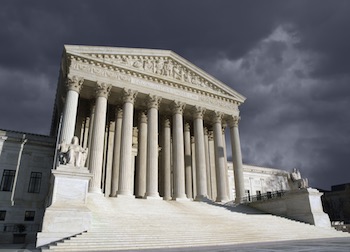
Doctrine of Equivalents and the Supreme Court
© 2002, Dawsey Co., LPA
July 2002
The U.S. Supreme Court issued a landmark patent decision on May 28, 2002. They unanimously vacated a decision of the U.S. Court of Appeals for the Federal Circuit (CAFC) in Festo Corp. v. Shoketsu Kinzoku Kogyo Kabushiki Co. Unfortunately, few people, other than patent attorneys, have recognized the importance of this case.
The decision has to do with the doctrine of equivalents and prosecution history estoppel. The doctrine of equivalents is an equitable doctrine established by the courts to protect patented inventions. It allows a patent owner to prove infringement even when the claims of the patent are not literally infringed. The doctrine of equivalents prevents potential infringers from avoiding liability by making minor changes to their device to avoid literal infringement.
The courts have also exercised their equitable powers to provide some certainty in the scope of the doctrine of equivalents. Prosecution history estoppel is one such limitation on the doctrine of equivalents. Prosecution history estoppel relates to the amendments, statements, arguments, and representations made during the prosecution of a patent application. It essentially prevents an applicant from attempting to argue that a narrowing statement, made during prosecution “for any reason related to patentability” that limits the scope of a patent, does not effect the scope of potential equivalents.
The CAFC decision had created an absolute bar to application of the doctrine of equivalents for all patent claim elements narrowed by amendment for reasons related to patentability during Patent & Trademark Office (PTO) prosecution. The CAFC explicitly abandoned the previous “flexible bar” approach that had permitted a case-by-case assessment of the breadth of prosecution history estoppel based upon the applicant’s reasons for claim amendments.
Fortunately, the U.S. Supreme Court held that the doctrine of equivalents may be limited by prosecution history estoppel, but prosecution history estoppel is not a “complete bar” to the doctrine of equivalents. The Court suggested that consideration be given to whether the patentee “surrendered the particular equivalents at issue.” One consideration of the Court was that the CAFC decision risked “disrupting the expectations of countless existing patent holders” who had “no reason to believe they were conceding all equivalents” by amending claims in past patent prosecution amendments. The Court noted that it saw “no reason why a narrowing amendment should be deemed to relinquish equivalents unforeseeable at the time of the amendment and beyond a fair interpretation of what was surrendered.” It is important to note that the patentee has the burden of proving that the narrowing amendment did not surrender the particular equivalent in dispute.
The Supreme Court’s decision in Festo should be a relief to patent applicants and cause potential patent infringers to seriously reconsider their actions.
About Us
Invention-Protection.com
Dawsey IP is dedicated to providing the highest quality intellectual property legal services to clients around the globe. Our intellectual property lawyers pride themselves in knowing our client’s businesses so that we can better educate our clients on the legal risks associated with their business decisions. This often includes strategically monitoring competitor’s intellectual property portfolios, as well as participating in meetings to road map a direction for the future of our client’s patent and trademark portfolios.
Categories
- copyright
- Famous Inventors' Patents
- Firm News
- Historic Patents
- Invention Protection
- licensing
- News
- Newsletters
- Ohio Patents and Innovations from Ohio Inventors
- Patent Application
- Patent infringement
- patent prosecution
- Patents For Your Pets
- trademark
- Trademarks
- U.S. Design Patents
- U.S. Utillity Patents
- Weird and Wacky Patents
